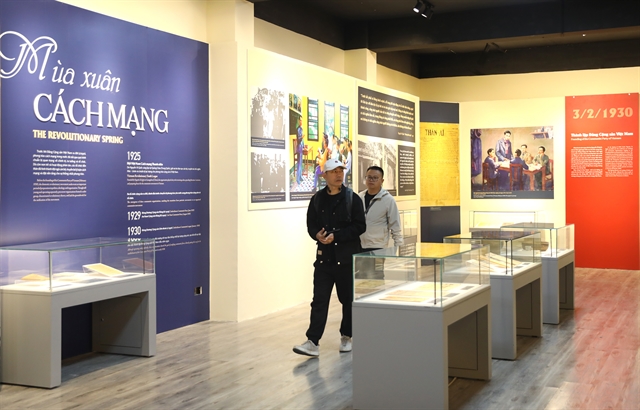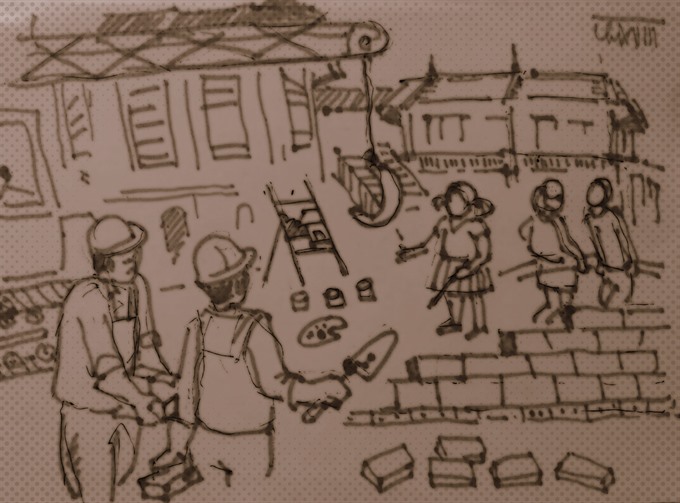 Talk Around Town
Talk Around Town

Like many other children living in Hà Nội, Nguyễn Hà Phương, 11 years old, is often taken by her mother to the Children’s Palace in Lý Thái Tổ Street to attend a dance class.
 |
Thu Hằng
Like many other children living in Hà Nội, Nguyễn Hà Phương, 11 years old, is often taken by her mother to the Children’s Palace in Lý Thái Tổ Street to attend a dance class.
Her class starts at 5pm on Wednesdays and Saturdays. But it seems that the lesson this Wednesday is more interesting than usual because Phương and her mother are now reassured that the building where she studies dance will continue to be a place of learning and enrichment for children—despite rumours to the contrary.
In recent days, a number of press agencies reported that the Hà Nội authorities planned to convert the Children’s Palace to a different use. The thought of that has raised the concern of many people in Hà Nội.
But on Tuesday, the Standing Committee of the Hà Nội Youth Union officially announced that the city has no plans to change the purpose of the building, which has regularly housed many activities for children.
Like many Hanoians, I was thrilled to hear that.
The decision proves that the city’s authorities understand the residents’ desires and care for children.
“I was very sad. A few days ago, I heard that the city planned to narrow the area of the Hà Nội Children’s Palace by recovering the French colonial building for the city to manage and use,” said Nguyễn Phương Nga, Phương’s mother.
“A few years ago, I heard about a similar plan in which the Children’s Palace would be removed to Cầu Giấy District. It is unreasonable because the city still lacks playgrounds for children.”
“But now I’m very glad to hear that there is not any plan to change the use of this building. My daughter can continue to learn here, where she has studied for many years,” Nga said.
Over the last half century, many generations of Hanoians have been attached to this place, which is considered a "childhood castle”.
Located on Lý Thái Tổ Street, the palace is next to the King Lý Thái Tổ monument and the legendary Hoàn Kiếm Lake, which attracts many domestic and foreign tourists.
During the French colonial period, the building was used as a kindergarten. This French-constructed building is the place where President Hồ Chí Minh and the French Government signed the preliminary agreement on March 6, 1946.
The building has been used to serve teenagers and children since 1954.
Following its glorious historical tradition, over the years, the Hà Nội Children’s Palace has maintained its position as a leading educational model outside school for children.
Every year, over 28,000 children come to study and play in 60 subjects such as arts, physical education and sports, and foreign languages.
As an entertainment centre for children in the capital, every year, the palace also organises many activities and events for children such as the International Children’s Day, the mid-autumn festival, New Year’s Eve, fashion design and singing contests, and other interesting activities.
Lê Minh Tuấn, a resident of Minh Khai Street, highlighted those events as he expressed his happiness with the Hà Nội City’s decision.
“The Children’s Palace is not only a place for children to learn and play but also is associated with many historical marks of Hà Nội. Its use should not be changed for any other needs.”
“It has become a familiar and indispensable address of many generations of Hanoians. It is also a place to store images of children’s activities from the beginning to the present,” he said.
He also said that on the weekends, his family often went to Hoàn Kiếm Lake, a pedestrian street near the Children’s Palace, and felt happy to see so many children playing and studying there.
“Hà Nội still needs more and more spaces for children,” Tuấn said.
Currently, we see only the Children’s Palace as a place dedicated to children. Some localities also have spaces for children, but they are small and sometimes also used for other local activities.
Due to rapid urbanisation, Hà Nội has few parks and playgrounds because many spaces earmarked for that purpose have been converted to parking, business and other projects.
According to preliminary statistics of the Hà Nội Planning and Architecture Department, the city now has more than 200 flower gardens and public playgrounds. The inner districts including Hoàn Kiếm, Hai Bà Trưng, Đống Đa and Ba Đình have 30 flower gardens and public playgrounds (not including playgrounds in the apartment complexes), Lao Động Thủ Đô (Labour Capital) online newspaper reported.
This is a modest figure that does not meet the needs of children.
Former deputy director of the labour ministry’s Child Care and Protection Administration Nguyễn Trọng An, said: "We know that a high-rise building will have a population equal to one village. Thus, there must be a space for children to play and participate in other activities. But constructors usually did not make the provision of land for public facilities."
He said the current solution was to attract private investment in building public facilities. If the investors only focus on building entertainment areas in trade centres, few children, and especially few poor children, will be able to access play areas.
Nguyễn Ngọc Bích, an architect living on Đống Đa District’s La Thành Street, said that for years, the city had concentrated on developing houses without paying adequate attention to public facilities.
"The major causes were the poor management of population growth, economic difficulties and poor urban management," he said.
The shortage of public space forces children to hunch in front of computer screens to play games, eschewing outdoor social activities.
Adults, especially the elderly, also have restricted opportunities for social communication and recreation.
"Housing is not only the house or apartment you live in, but also surrounding public facilities," Bích said.
Personally, I think it is high time that the city should have a plan to build more public facilities to meet the demands of urbanisation.
Public facilities should include playgrounds for children like the Children’s Palace. That will really show Hà Nội’s interest in children. — VNS




